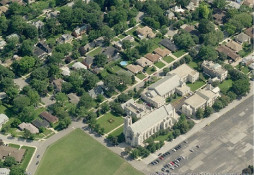<<< back< prevnext >

Article:
House of Worship Impact on Property Values

Occasionally we are confronted with the question of whether a church facility will enhance or detract from a neighborhood's property value. Many neighborhoods are resistant to change and uncertainty, as they want to protect their property values. The NIMBY (Not in my Back Yard) attitude can create issues for religious institutions and local governments trying to accommodate their citizens' desires while meeting the greater public good.
There have been a few studies going back as far as the 1990s that have reported mixed impacts either with slight positive or slight negative on home values in their proximity.
The Wall Street Journal (August 29, 2014) just reported the release of a new study in Hamburg Germany which found that condos located between 109 to 219 yards (100 to 200 meters), listed for an average of 4.8% more than other homes. The effect was similar across all religious buildings studied including churches, mosques and temples. They did find if you live less than 109 yards from a religious property the premium is erased. What we found interesting was that the effect was the same even for deconsecrated and converted churches. It should be noted, however, that Hamburg benefits from numerous beautiful and centuries old churches.
The study was reported in the journal Growth and Change which studied the listing prices of 4,832 condo units in Hamburg between 2002 and 2008. The study controlled for variables such as access to jobs, neighborhood quality and property type. Wolfgang Maennig, a Professor at the University of Hamburg Department of Economics and Social Sciences was a co-author of the report.
This data would not necessarily be directly comparable to the United States although its conclusions appear to be in line with the range of United States studies. The Wall Street Journal article cited a case study in Contemporary Economic Policy in 2012 that looked at the effect of a newly built Mormon temple in Omaha Nebraska on home prices. The co-author of the study Eric Thompson, Associate Professor of Economics, at the University of Nebraska-Lincoln, found no notable effect in prices.
While we have not done a rigorous study, our general impression has been that at a neighborhood level, the presence of a religious facility is generally neutral to somewhat positive based purely on a home value perspective. There are also numerous other economic and societal contributions that congregations add to communities which were not within the scope of these studies.
There have been a few studies going back as far as the 1990s that have reported mixed impacts either with slight positive or slight negative on home values in their proximity.
The Wall Street Journal (August 29, 2014) just reported the release of a new study in Hamburg Germany which found that condos located between 109 to 219 yards (100 to 200 meters), listed for an average of 4.8% more than other homes. The effect was similar across all religious buildings studied including churches, mosques and temples. They did find if you live less than 109 yards from a religious property the premium is erased. What we found interesting was that the effect was the same even for deconsecrated and converted churches. It should be noted, however, that Hamburg benefits from numerous beautiful and centuries old churches.
The study was reported in the journal Growth and Change which studied the listing prices of 4,832 condo units in Hamburg between 2002 and 2008. The study controlled for variables such as access to jobs, neighborhood quality and property type. Wolfgang Maennig, a Professor at the University of Hamburg Department of Economics and Social Sciences was a co-author of the report.
This data would not necessarily be directly comparable to the United States although its conclusions appear to be in line with the range of United States studies. The Wall Street Journal article cited a case study in Contemporary Economic Policy in 2012 that looked at the effect of a newly built Mormon temple in Omaha Nebraska on home prices. The co-author of the study Eric Thompson, Associate Professor of Economics, at the University of Nebraska-Lincoln, found no notable effect in prices.
While we have not done a rigorous study, our general impression has been that at a neighborhood level, the presence of a religious facility is generally neutral to somewhat positive based purely on a home value perspective. There are also numerous other economic and societal contributions that congregations add to communities which were not within the scope of these studies.



